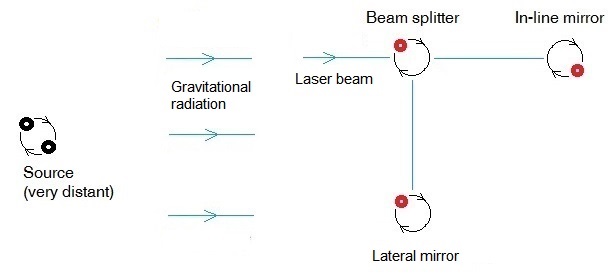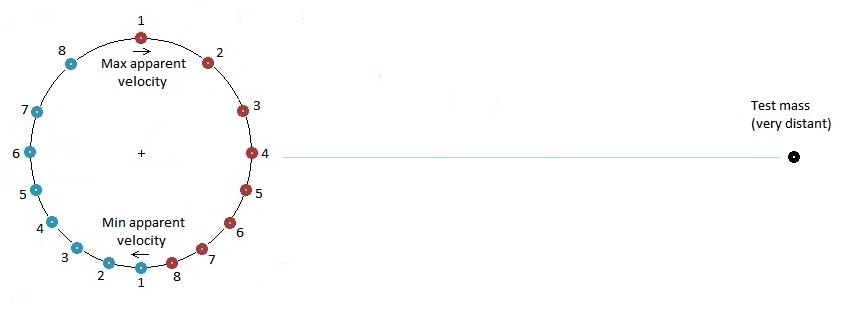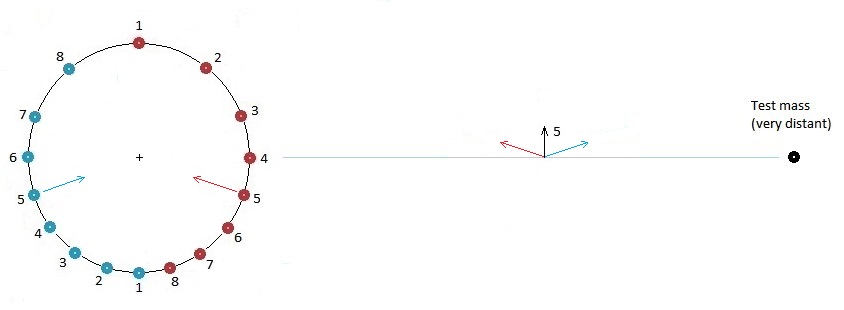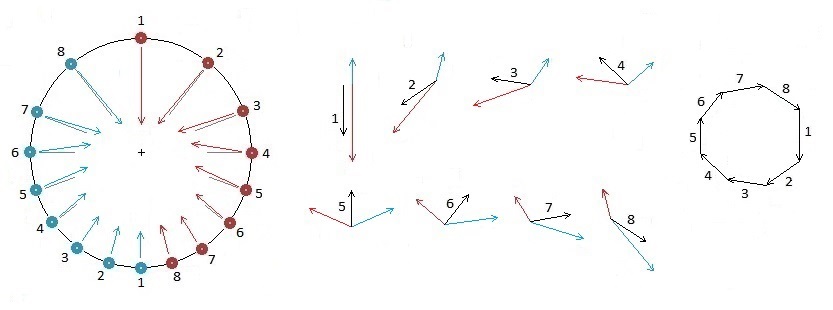Gravitational radiation
I have just completed an online course on Gravity run by FutureLearn. The head tutor was Pierre Binétruy, professor of physics at Université Paris Diderot.
The section on Gravitational Waves inspired me to see whether the observations could be explained by a force induced by relative acceleration.
In this article I will investigate this and derive some predictions, based on the following extract from my Mass and charge article.
Extract from 'Mass and charge'
Two equal orbiting massive bodies are viewed from a point on the plane of their circular orbit. When they are seen side-by-side, the one on the left is accelerating to the right and the one on the right is accelerating to the left. Because the effects of their motions travel at a finite speed, the approaching mass appears to move faster than the receding mass. Acceleration in a circular orbit varies with the square of the velocity. From the point of view of the observer there is a net transverse acceleration at this time.
When they appear in-line with the observer, one is behind the other. Because the effects of their motions travel at a finite speed, the furthest one appears retarded in its orbit and the nearest one more advanced. From the point of view of the observer there is also a net transverse acceleration at this time, but in the opposite direction to the side-by-side situation. In between these times there are transverse and in-line components to the observed net acceleration.
The observed changes in acceleration are experienced as gravitational radiation by the observer. The frequency of the radiation is twice the frequency of the orbital rotation.
The detection apparatus
The detection apparatus is called an interferometer. A laser beam is directed at an optical device called a beam splitter which splits the beam into two. A transmitted beam goes in one direction and a reflected beam goes in a direction at right angles to the transmitted beam. Both beams are then reflected back by mirrors so that they return to the beam splitter where they combine and then go on to produce an interference pattern at a detector.
The interference pattern depends on the path lengths from the beam splitter to the mirrors and back again. If the length of either path changes, the interference pattern changes too. The conventional explanation is that, as the gravitational radiation passes through the apparatus, the fabric of space-time is stretched and compressed causing differential changes to the path lengths of the two beams which results in a periodic change in the interference pattern at the detector.
It is a little more complicated than that,
as the gravitational radiation is assumed to travel at the speed of
light, one beam may travel with the gravitational
radiation.
In practice, the wavelength of the laser light is very much shorter than the the wavelength of the gravitational radiation.
The effect of the gravitational radiation on the interferometer
From the extract from my 'Mass and charge' article, it follows that a test mass some distance from the gravitational radiation source will move in a circular orbit under the influence of the gravitational radiation. Thus, the beam splitter and the two mirrors will move in a circular orbits.
There are additional forces due to the effect of 'passing masses' but this does not alter the following explanation. For a fuller analysis of the effect of the source on a distant test mass, see the Appendix at the end of this article.
In this example, one path of the interferometer is in-line with the direction of the source and other path is perpendicular to it. Due to the immense distance between the source and the interferometer, there is no phase difference between the orbits of the beam splitter and the lateral mirror. However, the phase difference between the orbits of the beam splitter and the in-line mirror will depend on the distance between them because gravitational radiation is assumed to travel at a finite speed, the speed of light.
In this interpretation, the changes in the interference pattern are due not to the stretching and compressing of the fabric of space-time but to the path length and phase differences between various parts of the interferometer caused by the forces induced by relative acceleration .
The interferometer

The red dots in this diagram show relative phases of the motion of various parts of the interferometer induced by the gravitational radiation. The motions of the Beam splitter and the Lateral mirror are in phase. There is a phase difference between the motion of the Beam splitter and the In-line mirror due to the finite velocity of the gravitational radiation.
The effect of the interferometer on the interference pattern
In the following diagrams I explore the effect of these path length and phase differences on the interference pattern for various gravitational wavelengths. The in-line and lateral path lengths are assumed to be equal in the absence of gravitational waves.
-
The total path length in the absence of gravitational radiation is 2L.
-
The radius of the circular orbits is r.
When L is equal to half the gravitational wavelength
The following diagrams show the changes in path length for four laser beam starting points in the orbit of the beam splitter.
Because the gravitational radiation travels at the same speed as the laser beam, the in-line mirror is at the same point in its orbit when the laser beam arrives, as the beam splitter was when the laser beam left.
-
The red dot is the place where the laser beam leaves, and arrives back at, the beam splitter.
-
The black dot is the place where the laser beam arrives at, and leaves, a mirror.
First starting point

The difference in the lengths of the paths
is 4r. The interference pattern has
changed.
A quarter cycle later

The length of each path is the same. The interference pattern is the same as it was prior to the arrival of the gravitational radiation.
A quarter cycle later

The difference in the lengths of the paths is -4r. The interference pattern has changed.
A quarter cycle later

The length of each path is the same. The interference pattern is the same as it was prior to the arrival of the gravitational radiation.
When L is equal to half the gravitational wavelength the interference pattern changes in step with the garvitational radiation.
When L is equal to a quarter of the gravitational wavelength
The following diagrams show the changes in path length for four starting points in the orbit of the beam splitter.
Because the gravitational radiation travels at the same speed as the laser beam, the in-line mirror is at the same point in its orbit when the laser beam arrives, as the beam splitter was when the laser beam left.
-
The red dot is the place where the laser beam leaves the beam splitter.
-
The black dot is the place where the laser beam arrives at, and leaves, a mirror.
-
The blue dot is the place where the laser beam arrives back at the beam splitter.
First starting point

The length
of each path is the same. The interference pattern is the same as
it was prior to the arrival of the gravitational
radiation.
A quarter cycle later

The length of each path is the same. The interference pattern is the same as it was prior to the arrival of the gravitational radiation.
A quarter cycle later

The length of each path is the same. The interference pattern is the same as it was prior to the arrival of the gravitational radiation.
A quarter
cycle later

The length
of each path is the same. The interference pattern is the same as
it was prior to the arrival of the gravitational
radiation.
When L is
equal to a quarter of the gravitational wavelength the interference
pattern stays the same as it was prior to the arrival of the
gravitational radiation.
So, gravitational waves and their detection can be explained by a force induced by relative acceleration.
The predictions are:
-
That the interferometer is most sensitive to waves coming from a source in the plane of the light paths.
-
That the interferometer is sensitive to certain wavelengths and not to others.
A discrepency explained
In the
above diagrams, the beam splitter and the mirrors are shown
completing exactly a half, or a quarter, of their orbits in the
time it takes for the laser beam to travel between them in spite of
the fact that the distance between them varies by as much as
2r.
The explanation is that L is so much bigger than r. We are trying to detect a difference in the order of 2r over a distance L, a ratio of 2r/L, which is tiny. However, the difference in the orbital position compared to L will be in the order of (2r/L)2 , or less, which is so small that it can be ignored.
Also, any relativistic effects, due to the movement of the components, are negiligible.
What if the
speed of gravitational radiation were to be
infinite
It has been suggested that the speed of gravitational radiation may be infinite. Follow the above procedures with that assumption and you find that the interferometer is not capable of detecting the radiation. As it is now certain that it has been detected by this method, the finite speed of propagation must be accepted. A speed of 'c' is a reasonable assumption at this stage.
Consider this scenario.
-
A test mass is a very long way from a source of gravitational radiation.
-
The source consists of two equal masses in the same circular orbit.
-
The test mass is in the plane of the source's orbit.
The source mass approaching the test mass appears to move faster than the source mass receding from the test mass.
The red dots represent the apparent postions of the source mass nearest to the test mass, numbered 1 to 8,at equal time intervals as seen fom the test mass.
The blue dots represent the apparent postions of the furthest source mass, at the same times,.
The effects of relativity, other than the finite speed of light, are not considered.

Acceleration towards the centre of the orbit
The red and blue arrows in this diagram are the acceleration vectors for the red and blue masses at point 5 in their orbit. The masses appear to be in-line at this time.The black arrow is the resultant acceleration vector as viewed from the test mass.

The red and blue arrows in the following diagram are the acceleration vectors for the red and blue masses at all the numbered points in their orbit. The black arrows are the resultant acceleration vectors. For example, at time 1, acceleration (proportional to the square of the velocity) is maximum for the approaching red mass and minimum for the receding blue mass.

Adding the resultant vectors, in time, for these few points results in a roughly circular curve with the vectors acting in a clockwise sense. The radiation causes the test mass to move in a clockwise circular orbit.
Mike Holden – Jul 2016